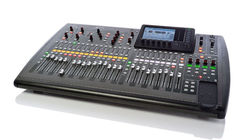
Digital sound desks are both similar
and different to an analogue desk for many reasons; firstly digital desks mix
digital signals not analogue signals and therefore a sound desk cannot be both.
Another key difference is that you may only have 10 faders but you could have
40 inputs due the nature of pages; this means your desk can be relatively
compact but can handle huge amounts on inputs. The last key different is a
digital desk only has one set of knobs for all the channels; you have to select
what channel you have to alter but the actual knobs do the same thing. Digital
desks may also include parametric EQs, compressors, gates and many other signal
processors built into the console.
In the centre of the desk there are usually several knobs; the first is always the gain control. Here most of the noise of interference is picked up, because of the high gains needed for microphones. Balanced inputs, such as XLR will reduce interference problems.
The auxiliary send routes some of the incoming signal to a bus which then can be routed to external devices such as monitors. Auxiliary sends can either be pre-fader or post-fader, the level of a pre-fader send is set by the auxiliary knob whereas the post-fader send is set by the position of the fader. Pre-faders are normally used for monitors and post-faders are normally for reverb.
The next section is normally the Equalization section of the EQ; it affects the signal by separately reducing or boosting a range of frequencies, e.g., bass, mids, and treble. You can connect up further Equalizers to have better control however this isn’t always needed with digital desks.
You may also have a pan control, PFL button, mute button or a grouping tool. The pan decodes whether the audio is sent to the left or right or both. PFL stands for pre-fade listening and you can listen to the mix and alter certain attributes without it going live. Mute does what it says, it mutes the channel and grouping allows you to connect the channel up to a group for group mutes or group levels.
Subgroup and main output fader controls are often found together on the right hand side of the mixer or, on larger consoles, in a centre section of many banks of input channels. Headphone connections are often found here and local loudspeaker monitoring controls. Talkback controls allow conversation with the artist through their monitors, headphones or in-ear monitor. There may also be meters for you to see how loud the mix is.
Digital desks are usually a lot more expensive than q analogue desk due to the amount of equipment built in; they are less likely to have interference from devices such as mobile phones and can often fully support digital multi-cores (multi-cores that use one CAT5 cable instead of many individual microphone cables).
In the centre of the desk there are usually several knobs; the first is always the gain control. Here most of the noise of interference is picked up, because of the high gains needed for microphones. Balanced inputs, such as XLR will reduce interference problems.
The auxiliary send routes some of the incoming signal to a bus which then can be routed to external devices such as monitors. Auxiliary sends can either be pre-fader or post-fader, the level of a pre-fader send is set by the auxiliary knob whereas the post-fader send is set by the position of the fader. Pre-faders are normally used for monitors and post-faders are normally for reverb.
The next section is normally the Equalization section of the EQ; it affects the signal by separately reducing or boosting a range of frequencies, e.g., bass, mids, and treble. You can connect up further Equalizers to have better control however this isn’t always needed with digital desks.
You may also have a pan control, PFL button, mute button or a grouping tool. The pan decodes whether the audio is sent to the left or right or both. PFL stands for pre-fade listening and you can listen to the mix and alter certain attributes without it going live. Mute does what it says, it mutes the channel and grouping allows you to connect the channel up to a group for group mutes or group levels.
Subgroup and main output fader controls are often found together on the right hand side of the mixer or, on larger consoles, in a centre section of many banks of input channels. Headphone connections are often found here and local loudspeaker monitoring controls. Talkback controls allow conversation with the artist through their monitors, headphones or in-ear monitor. There may also be meters for you to see how loud the mix is.
Digital desks are usually a lot more expensive than q analogue desk due to the amount of equipment built in; they are less likely to have interference from devices such as mobile phones and can often fully support digital multi-cores (multi-cores that use one CAT5 cable instead of many individual microphone cables).